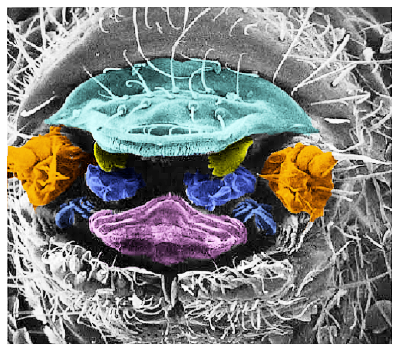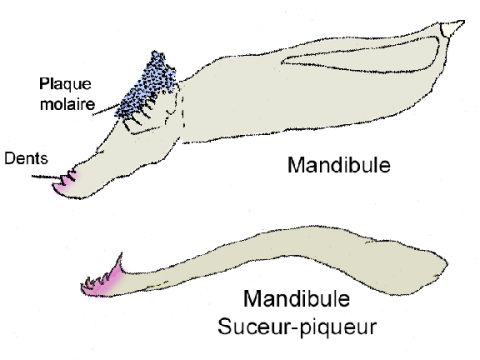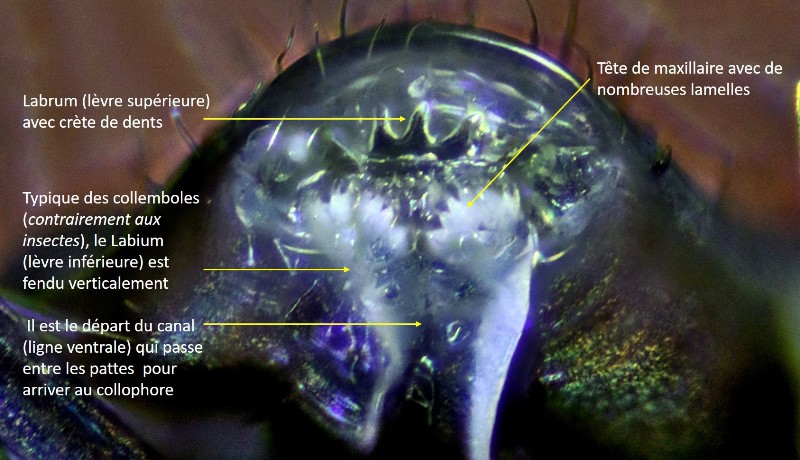The mouthparts are not visible because they are embedded in a cavity (This is among other features distinguishing springtails from insects). The species thus defined are described as enthroned. Oral parts play a very important role in the identification and classification of species.
The mandibles and maxillae are mainly pieces "grinders" but there are also mandibles adapted for the species called "sucker-breaker". Below, oral pieces of a Tomoceridae1 (Pogonognathellus flavescens) where we distinguish the five constituent parts of the oral apparatus, namely:
 - Labrum (green). This part is an upper lip that covers the other mouthparts.
- Labrum (green). This part is an upper lip that covers the other mouthparts.
- Mandibles (yellow). Two in number, they are arranged symmetrically and each carries a molar plate * and an incisal part (tooth). The tips with solid teeth allow springtail to pull food materials on the substrate, as the molar plates, it is generally accepted that they are used to grind food. The mandibular movements are characterized by rotations around the dorso-ventral axis (that is, if we look at the mouth of face, by alternating left / right translations) as well as by protraction and retractaion movements. (outbound / inward), performed in order to shear the food particles or grind the fragments between the mandibular molar plates.

- Maxillae (blue). There are two of them, they are located just above the hypopharynx. Each maxillary has a "head" called capitulum (see examples in the illustration below) 2. During the bite, maxillae and mandibles move synchronously. The analysis of the maxillary movement shows that they contribute to stabilizing the mandibular movement. The mandible and the maxillary thus interact with each other via an articular dart located on the dorsal side of the maxillary stipes, supported by structures of the hypopharynx and cephalic capsule. The fact that springtails are entognathes and the very small dimensions of their mouthparts have long been played in the lack of knowledge of the movements involved during the absorption of food. Only the advent of "synchrotron" 3D imaging techniques made it possible to lift the veil.
 - Hypopharynx (mauve) is a piece located in the upper part of the labium under the mandibles and between the maxillae. It plays the role of a kind of tongue and mouth floor whose main function is to help mix food with saliva.
- Hypopharynx (mauve) is a piece located in the upper part of the labium under the mandibles and between the maxillae. It plays the role of a kind of tongue and mouth floor whose main function is to help mix food with saliva.
- Maxillary palps (orange) consist of a pair of appendages useful especially for grasping food. I found a definition of the historian Jules Michelet who was also an entomologist and who described them in his works "Insects" published in 1857: "small hands palpate palate handle, return what is brought" .
- Labium not marked by a color constitutes the lower part, a kind of lip arranged in an arc defining the contours of the mouth and going up to the commissure.
Below, the mouthpieces of a "Dicyrtoma-fusca"

Note: Some Poduromorphs (Odeontellidae, and Neanuridae) have mouthpieces of the nozzle-pricking type. This is known as a mouth cone. Indeed, during their evolution and taking into account their diet, the molar plaques became useless and therefore disappeared.
Below3, mouth cone of Neanuridae (Deutonura monticola). Note on the right view the presence of a "canal" which starts from the lower lip located at the base of the oral cone. This channel has a specific function. To learn more about it, read the article on the ventral tube.

Other species such as Brachystomellidae no longer even have mandibles and are content to ingest food particles embedded in a liquid suspension.
1: Illustration adapted from Biology of the Sprintails. S.P. Hopkin, from Atlas of the Biology of Soil Arthropods - G.Eisenbeis and W.Richard (1985)
2: Sketches adapted from: Structural mouthpart interaction evolved already in the earliest lineages of insects. Alexander Blanke, Peter T. Ruhr, Rajmund Mokso, Pablo Villanueva, Fabian Wilde, Marco Stampanoni, Kentaro Uesugi, Ryuichiro Machida, Bernhard Misof - 23/07/2005 The Royal Society.
3: Photographs taken with a binocular magnifier x160 magnification. © Philippe Garcelon